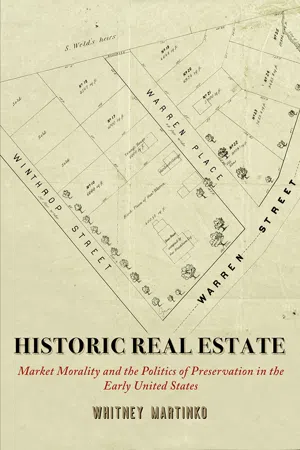
Historic Real Estate
Market Morality and the Politics of Preservation in the Early United States
- 328 pages
- English
- ePUB (mobile friendly)
- Available on iOS & Android
Historic Real Estate
Market Morality and the Politics of Preservation in the Early United States
About this book
A detailed study of early historical preservation efforts between the 1780s and the 1850s
In Historic Real Estate, Whitney Martinko shows how Americans in the fledgling United States pointed to evidence of the past in the world around them and debated whether, and how, to preserve historic structures as permanent features of the new nation's landscape. From Indigenous mounds in the Ohio Valley to Independence Hall in Philadelphia; from Benjamin Franklin's childhood home in Boston to St. Philip's Episcopal Church in Charleston, South Carolina; from Dutch colonial manors of the Hudson Valley to Henry Clay's Kentucky estate, early advocates of preservation strove not only to place boundaries on competitive real estate markets but also to determine what should not be for sale, how consumers should behave, and how certain types of labor should be valued.
Before historic preservation existed as we know it today, many Americans articulated eclectic and sometimes contradictory definitions of architectural preservation to work out practical strategies for defining the relationship between public good and private profit. In arguing for the preservation of houses of worship and Indigenous earthworks, for example, some invoked the "public interest" of their stewards to strengthen corporate control of these collective spaces. Meanwhile, businessmen and political partisans adopted preservation of commercial sites to create opportunities for, and limits on, individual profit in a growing marketplace of goods. And owners of old houses and ancestral estates developed methods of preservation to reconcile competing demands for the seclusion of, and access to, American homes to shape the ways that capitalism affected family economies. In these ways, individuals harnessed preservation to garner political, economic, and social profit from the performance of public service.
Ultimately, Martinko argues, by portraying the problems of the real estate market as social rather than economic, advocates of preservation affirmed a capitalist system of land development by promising to make it moral.
Frequently asked questions
- Essential is ideal for learners and professionals who enjoy exploring a wide range of subjects. Access the Essential Library with 800,000+ trusted titles and best-sellers across business, personal growth, and the humanities. Includes unlimited reading time and Standard Read Aloud voice.
- Complete: Perfect for advanced learners and researchers needing full, unrestricted access. Unlock 1.4M+ books across hundreds of subjects, including academic and specialized titles. The Complete Plan also includes advanced features like Premium Read Aloud and Research Assistant.
Please note we cannot support devices running on iOS 13 and Android 7 or earlier. Learn more about using the app.
Information
Notes
AAS | American Antiquarian Society, Worcester, Massachusetts |
HABS | Historic American Buildings Survey, Prints and Photographs Online Catalog, Library of Congress, http://www.loc.gov/pictures/collection/hh/ |
HALS | Historic American Landscapes Survey, Prints and Photographs Online Catalog, Library of Congress, http://www.loc.gov/pictures/collection/hh/ |
HCFP | Henry Clay Family Papers Series II, Library of Congress, Washington, D.C. |
HSP | Historical Society of Pennsylvania, Philadelphia |
MDOCA | Manuscripts and Documents of the Ohio Company of Associates, Special Collections, Marietta College, Marietta, Ohio |
MVLAER | Mount Vernon Ladies Association Early Records, Fred W. Smith National Library for the Study of George Washington, Mount Vernon, Virginia |
NIRC | Narragansett Indian Records Collection, Rhode Island State Archives, Providence |
RIHS | Rhode Island Historical Society, Providence |
RISA | Rhode Island State Archives, Providence |
RPP | Rufus Putnam Papers, Special Collections, Marietta College, Marietta, Ohio |
TSTFR | Touro Synagogue Trust Fund Records (ID 06/06.01/1636-1836 C#27), Treasury Department Trust Fund Records, 1823–1891, Rhode Island State Archives, Providence |
Table of contents
- Cover
- Half title
- Title
- Copyright
- Dedication
- Contents
- Preface
- Introduction. Architecture, Society, and Economy in the Early United States
- I. CORPORATE PROPERTIES
- II. COMMERCIAL SITES
- III. DOMESTIC SPACES
- Epilogue. Rethinking Mount Vernon and Legacies of Preservation
- Notes
- Index
- Acknowledgments